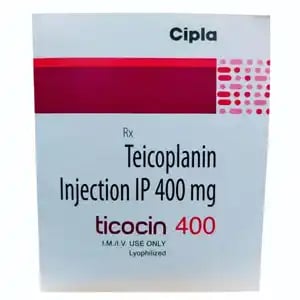Similar Medicine Of T-Planin 400 Injection
Discover the Benefits of ABHA Card registration
Simplify your healthcare journey with Indian Government's ABHA card. Get your card today!
Create ABHAIntroduction to T-Planin 400 Injection
T-PLANIN 400 MG Injection contains Teicoplanin (400 mg), a broad-spectrum glycopeptide antibiotic used to treat serious bacterial infections caused by Gram-positive bacteria, including MRSA (Methicillin-resistant Staphylococcus aureus). T-PLANIN 400 MG Injection is administered under strict medical supervision, usually in a hospital setting, ensuring effective treatment for severe infections that do not respond to standard antibiotics.
How T-Planin 400 Injection works
The active ingredient, Teicoplanin, works by inhibiting bacterial cell wall synthesis, which is essential for bacterial growth and survival. This action leads to the weakening of the bacterial cell wall, causing the bacteria to burst and die. T-PLANIN is highly effective against multi-drug-resistant bacteria, including MRSA. This targeted approach helps eliminate infections that are difficult to treat with conventional antibiotics.
How To Use T-Planin 400 Injection
- Dosage: The typical dose ranges from 6-12 mg/kg, depending on the severity of the infection.
- Administered as an intravenous (IV) injection or intramuscular (IM) injection by a healthcare professional.
- Administration: Given under strict medical supervision in a hospital or clinical setting.
- Administered slowly over 3-5 minutes (if IV bolus) or as an infusion over 30 minutes.
Special Precautions About T-Planin 400 Injection
- Kidney Impairment: Dose adjustment may be needed in patients with renal issues.
- Hearing Issues: Use cautiously in patients with a history of hearing problems, as it may cause ototoxicity.
- Allergies: Avoid if allergic to glycopeptide antibiotics like Vancomycin.
- Long-term Use: Prolonged use may lead to superinfections or fungal infections.
Benefits Of T-Planin 400 Injection
- Effective against drug-resistant bacteria, including MRSA.
- Treats severe infections like septicemia, pneumonia, and bone infections.
- Less nephrotoxic compared to other antibiotics like Vancomycin.
- Requires less frequent dosing due to its long half-life.
Side Effects Of T-Planin 400 Injection
- Nausea
- rash
- fever
- diarrhea
- Pain, redness, or swelling at the injection site
- Fever or chills
- Vomiting
- Rash or itching
- Headache
What If I Missed A Dose Of T-Planin 400 Injection
- Since T-PLANIN is administered in a healthcare setting, missing a dose is rare.
- If a dose is missed, the healthcare provider will adjust the schedule accordingly.
Health And Lifestyle
Drug Interaction
- Aminoglycoside antibiotics (e.g., Gentamicin): Increases the risk of kidney and ear toxicity.
- Loop diuretics (e.g., Furosemide): May increase the risk of ototoxicity.
- Cyclosporine: Risk of kidney damage when used together.
- Vancomycin: Increases the risk of nephrotoxicity and ototoxicity.
Drug Food Interaction
- No direct food interactions.
Disease Explanation

Severe bacterial infections occur when bacteria enter the bloodstream or deep tissues, causing life-threatening conditions. MRSA (Methicillin-resistant Staphylococcus aureus) is a type of bacteria that is resistant to many antibiotics, making infections difficult to treat.
Safety Advice for T-Planin 400 Injection
- High risk
- Moderate risk
- Safe

Avoid alcohol during treatment to reduce the risk of liver damage.

Dose adjustments may be required in kidney impairment to prevent toxicity.

Use cautiously in liver disorders; regular liver function tests may be needed.

Use only if prescribed by a doctor after evaluating the risks.

Consult a doctor before use, as it may pass into breast milk.

May cause dizziness; avoid driving if you feel lightheaded.
Tips of T-Planin 400 Injection
- Complete the full course even if you feel better.
- Inform your doctor if you experience hearing problems or changes in kidney function.
- Avoid alcohol to reduce the burden on your liver and kidneys.
- Report any allergic reactions immediately to your healthcare provider.
- Regular blood tests may be required to monitor kidney function during long-term use.
FactBox of T-Planin 400 Injection
- Category: Glycopeptide Antibiotic
- Active Ingredient: Teicoplanin (400 mg)
- Form: Injection (IV/IM)
- Prescription Required: Yes
Storage of T-Planin 400 Injection
- Store at 2°C to 8°C (refrigerated) if not used immediately.
- Protect from light and moisture.
- Do not freeze the solution.
- Keep out of reach of children.
Dosage of T-Planin 400 Injection
- Adults: 6–12 mg/kg once daily, depending on the infection.
- Children: Dose adjusted based on body weight.
- Kidney Impairment: Dose adjustments may be required.
Synopsis of T-Planin 400 Injection
T-PLANIN 400 MG Injection is a powerful glycopeptide antibiotic used to treat severe bacterial infections, including MRSA, sepsis, and pneumonia. It works by inhibiting bacterial cell wall synthesis, effectively eliminating resistant bacteria and preventing the spread of infection.
FAQ's on T-Planin 400 Injection
What is T-PLANIN 400 MG Injection used for?
How does T-PLANIN work?
Can T-PLANIN treat MRSA infections?
How is T-PLANIN administered?
Is T-PLANIN safe during pregnancy?
Can I take T-PLANIN at home?
Does T-PLANIN cause kidney problems?
Is T-PLANIN a broad-spectrum antibiotic?
Can T-PLANIN cause allergic reactions?
How long does it take for T-PLANIN to work?
How should T-PLANIN be stored?
Is T-PLANIN safe for children?
Can T-PLANIN cause hearing loss?
Is T-PLANIN effective for pneumonia?
How long is the course of treatment with T-PLANIN?
Can T-PLANIN cause fever?
Is T-PLANIN the same as Vancomycin?
Does T-PLANIN cause drowsiness?
Can T-PLANIN be used for skin infections?
Does T-PLANIN affect blood sugar levels?
 Written By
Written By
uma k
Content Updated on
Saturday, 8 Feburary, 2025









